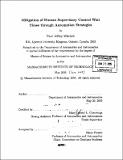| dc.contributor.advisor | Mary (Missy) L. Cummings. | en_US |
| dc.contributor.author | Mitchell, Paul Jeffrey | en_US |
| dc.contributor.other | Massachusetts Institute of Technology. Dept. of Aeronautics and Astronautics. | en_US |
| dc.date.accessioned | 2006-03-29T18:44:30Z | |
| dc.date.available | 2006-03-29T18:44:30Z | |
| dc.date.copyright | 2005 | en_US |
| dc.date.issued | 2005 | en_US |
| dc.identifier.uri | http://hdl.handle.net/1721.1/32437 | |
| dc.description | Thesis (S.M.)--Massachusetts Institute of Technology, Dept. of Aeronautics and Astronautics, 2005. | en_US |
| dc.description | Includes bibliographical references (p. 129-134). | en_US |
| dc.description.abstract | The application of network centric operations principles to human supervisory control (HSC) domains means that humans are increasingly being asked to manage multiple simultaneous HSC processes. However, increases in the number of available information sources, volume of information and operational tempo, all which place higher cognitive demands on operators, could become constraints limiting the success of network centric processes. In time-pressured scenarios typical of networked command and control scenarios, efficiently allocating attention between a set of dynamic tasks is crucial for mission success. Inefficient attention allocation leads to system wait times, which could eventually lead to critical events such as missed times on targets and degraded overall mission success. One potential solution to mitigating wait times is the introduction of automated decision support in order to relieve operator workload. However, it is not obvious what automated decision support is appropriate, as higher levels of automation may result in a situation awareness decrement and other problems typically associated with excessive automation such as automation bias. To assess the impact of increasing levels of automation on human and system performance in a time-critical HSC multiple task management context, an experiment was run in which an operator simultaneously managed four highly autonomous unmanned aerial vehicles executing an air tasking order, with the overall goal of destroying a pre-determined set of targets within a limited time period. | en_US |
| dc.description.abstract | (cont.) A 4x2(3) repeated measures design was utilized in which the level of decision support provided to operators was a between-subjects factor and level of re-planning, which represents operational tempo, a within-subjects factor. The automated decision support, which took the basic form of a timeline display to aid with scheduling, had four increasing levels: manual, passive, collaborative, and management-by-exception. Level of re-planning refers to how much operators were required to adjust the initial plan in flight, based on unexpected occurrences such as changing deadlines or target sets, and included low and high levels. The passive level of decision support, which provided assistance to the user through color coding and re-organization of scheduling information, was the best overall performer as it had no major drawbacks. Management-by-exception had the best performance across several metrics but had a greater number of catastrophic events occur where a UAV erroneously destroyed a friendly target. The manual level performed better than expected, but had a similarly high critical event rate. Contrary to expectations, the collaborative level of decision support, which provided predictions for possible periods of task overload as well as possible courses of action to relieve the high workload, had the worst performance. This is attributable to an unintended consequence of the automation where the graphical visualization of the computer's predictions caused users to try to globally optimize the schedules for all UAVs instead of locally optimizing schedules in the immediate future, resulting in them being over- whelmed. | en_US |
| dc.description.abstract | (cont.) Total system wait time across both experimental factors was dominated by wait time caused by lack of situation awareness, which is difficult to eliminate, implying that there will be a clear upper limit on the number of vehicles that any one person can supervise because of the need to stay cognitively aware of unfolding events. | en_US |
| dc.description.statementofresponsibility | by Paul Jeffrey Mitchell. | en_US |
| dc.format.extent | 181 p. | en_US |
| dc.format.extent | 9343094 bytes | |
| dc.format.extent | 9354092 bytes | |
| dc.format.mimetype | application/pdf | |
| dc.format.mimetype | application/pdf | |
| dc.language.iso | eng | en_US |
| dc.publisher | Massachusetts Institute of Technology | en_US |
| dc.rights | M.I.T. theses are protected by copyright. They may be viewed from this source for any purpose, but reproduction or distribution in any format is prohibited without written permission. See provided URL for inquiries about permission. | en_US |
| dc.rights.uri | http://dspace.mit.edu/handle/1721.1/7582 | |
| dc.subject | Aeronautics and Astronautics. | en_US |
| dc.title | Mitigation of human supervisory control wait times through automation strategies | en_US |
| dc.title.alternative | Mitigation of HSC wait times through automation strategies | en_US |
| dc.type | Thesis | en_US |
| dc.description.degree | S.M. | en_US |
| dc.contributor.department | Massachusetts Institute of Technology. Department of Aeronautics and Astronautics | |
| dc.identifier.oclc | 61718925 | en_US |
